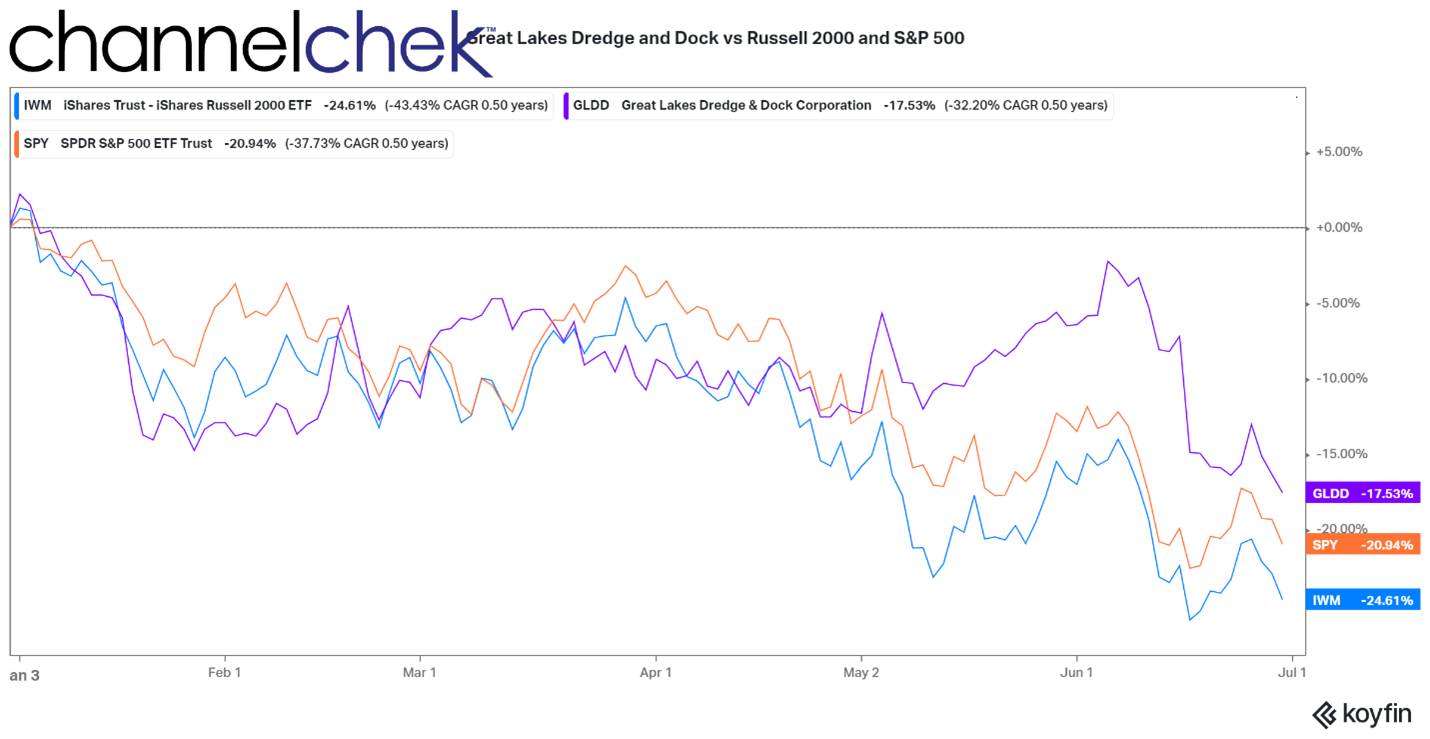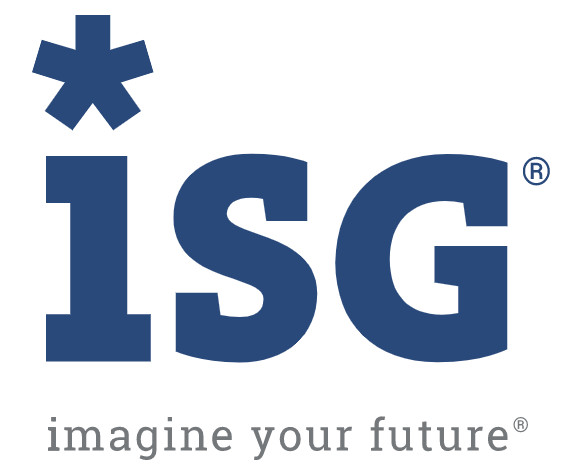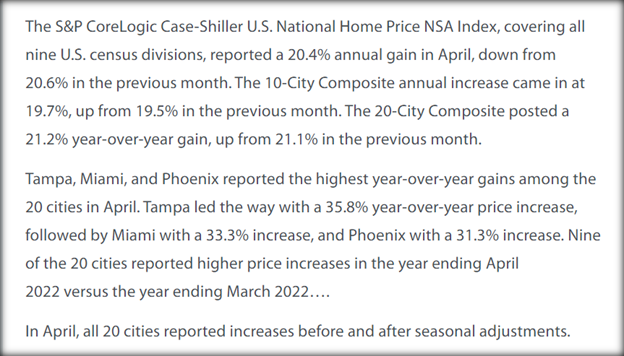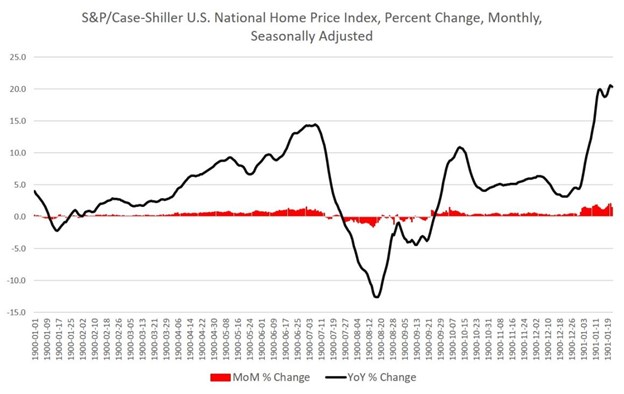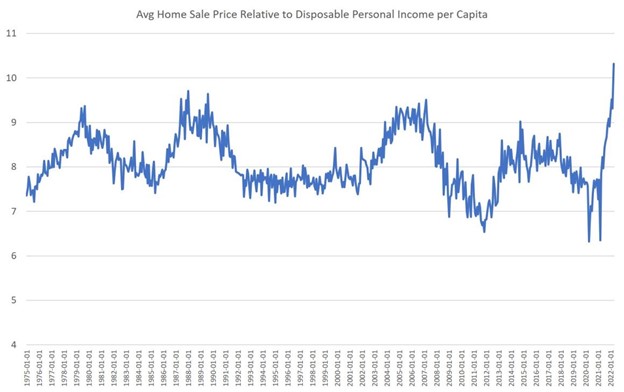
Tuesday, July 5, 2022
Energy Industry Report
The outlook for energy stocks remains favorable
Michael Heim, CFA, Senior Research Analyst, Noble Capital Markets, Inc.
Refer to end of report for Analyst Certification & Disclosures
- Energy stocks finally cooled off after five consecutive quarters of gains. The energy stock index declined 6.4% in the June quarter due to weakness in the overall market. The S&P Composite Index declined 16.4% during the quarter.
- Oil prices continued the climb begun in the spring of 2020 rising 5.5% in the quarter. The climb may have come to an end, however, with WTI prices peaking at $120 per barrel in the first week of June before settling at current levels near $108 per barrel. Supply concerns associated with the Ukraine conflict have been replaced by worries that economic tightening will lead to a slowdown in the world economy. OPEC announced production increases right at the end of the quarter, further putting pressure on prices. Active rigs have almost tripled in the last two years but remain below pre-pandemic levels and are only one-third of peak levels in 2015.
- Like oil prices, natural gas prices were strong in April and May but fell sharply in June. For the quarter, spot gas prices declined 3.9%. Gas in storage remains near the bottom of historical levels as the industry begins to refill storage fields
- Energy industry fundamentals remain strong. The recent drop in oil and gas prices does not concern us as prices are still well above the levels assumed in our financial and valuation models. Companies able to expand drilling efforts are doing so at a very high return on equity. Cash flow generation is high, and companies are facing the envious situation of trying to decide what to do with the cash. We maintain our positive bias on the group and favor small cap energy stocks with the ability to expand operations.
Energy Stocks
Energy stocks, as measured by the XLE Energy Index, finally cooled off after five consecutive quarters of gains. The XLE declined 6.4% in the June quarter. The decline was largely due to weakness in the overall market as oil and natural gas prices were largely unchanged. The S&P Composite Index declined 16.4% during the quarter. Looking at the XLE performance, it is interesting to note that the index’s performance was up sharply until hitting a peak on June 8th and then declining 15% in the last three weeks of the quarter.
Oil Prices
Oil prices continued the climb begun in the spring of 2020. The climb may have come to an end with WTI prices peaking at $120 per barrel in the first week of June before settling at current levels near $108 per barrel. Supply concerns associated with the Ukraine conflict have been replaced by worries that economic tightening will lead to a slowdown in the world economy. OPEC announced production increases right at the end of the quarter, further putting pressure on prices. The gap between Brent and WTI pricing has grown with Brent oil prices now commanding a $7/bbl. premium. Oil future prices are currently backward declining a few dollars each month and falling below $100 by yearend. Drillers are beginning to react to higher oil prices, but the response has been slow. Active rigs have almost tripled in the last two years but remain below pre-pandemic levels and are only one-third of peak levels in 2015. As the chart below shows, there has been a disconnect between the oil rig count and oil prices in recent years that has become only more exaggerated in recent months with oil prices rising above $100.
Figure #1

Source: Baker-Hughes
Natural Gas Prices
Like oil prices, natural gas prices were strong in April and May but fell sharply in June. For the quarter, spot gas prices declined 3.9%. Gas in storage remains near the bottom of historical levels as the industry begins to refill storage fields. Gas storage is about 300 billion cubic feet or 12% below the trailing five-year average. This will most likely keep natural gas prices at elevated levels until the injections season ends in November.
Figure #2

Outlook
Energy industry fundamentals remain strong. The recent drop in oil and gas prices does not concern us as prices are still well above the levels assumed in our financial and valuation models. Companies able to expand drilling efforts are doing so at a very high return on equity. Cash flow generation is high, and companies are facing the envious situation of trying to decide what to do with the cash. Debt levels have been pared down and managements are reluctant to initiate/raise above in case the industry goes into a down cycle forcing them to reverse course. Share repurchase remains a viable option especially if energy stocks continue to be weak alongside the overall market. We maintain our positive bias on the group and favor small cap energy stocks with the ability to expand operations.
GENERAL DISCLAIMERS
All statements or opinions contained herein that include the words “we”, “us”, or “our” are solely the responsibility of Noble Capital Markets, Inc. (“Noble”) and do not necessarily reflect statements or opinions expressed by any person or party affiliated with the company mentioned in this report. Any opinions expressed herein are subject to change without notice. All information provided herein is based on public and non-public information believed to be accurate and reliable, but is not necessarily complete and cannot be guaranteed. No judgment is hereby expressed or should be implied as to the suitability of any security described herein for any specific investor or any specific investment portfolio. The decision to undertake any investment regarding the security mentioned herein should be made by each reader of this publication based on its own appraisal of the implications and risks of such decision.
This publication is intended for information purposes only and shall not constitute an offer to buy/sell or the solicitation of an offer to buy/sell any security mentioned in this report, nor shall there be any sale of the security herein in any state or domicile in which said offer, solicitation or sale would be unlawful prior to registration or qualification under the securities laws of any such state or domicile. This publication and all information, comments, statements or opinions contained or expressed herein are applicable only as of the date of this publication and subject to change without prior notice. Past performance is not indicative of future results.
Noble accepts no liability for loss arising from the use of the material in this report, except that this exclusion of liability does not apply to the extent that such liability arises under specific statutes or regulations applicable to Noble. This report is not to be relied upon as a substitute for the exercising of independent judgement. Noble may have published, and may in the future publish, other research reports that are inconsistent with, and reach different conclusions from, the information provided in this report. Noble is under no obligation to bring to the attention of any recipient of this report, any past or future reports. Investors should only consider this report as single factor in making an investment decision.
IMPORTANT DISCLOSURES
This publication is confidential for the information of the addressee only and may not be reproduced in whole or in part, copies circulated, or discussed to another party, without the written consent of Noble Capital Markets, Inc. (“Noble”). Noble seeks to update its research as appropriate, but may be unable to do so based upon various regulatory constraints. Research reports are not published at regular intervals; publication times and dates are based upon the analyst’s judgement. Noble professionals including traders, salespeople and investment bankers may provide written or oral market commentary, or discuss trading strategies to Noble clients and the Noble proprietary trading desk that reflect opinions that are contrary to the opinions expressed in this research report.
The majority of companies that Noble follows are emerging growth companies. Securities in these companies involve a higher degree of risk and more volatility than the securities of more established companies. The securities discussed in Noble research reports may not be suitable for some investors and as such, investors must take extra care and make their own determination of the appropriateness of an investment based upon risk tolerance, investment objectives and financial status.
Company Specific Disclosures
The following disclosures relate to relationships between Noble and the company (the “Company”) covered by the Noble Research Division and referred to in this research report.
Noble is not a market maker in any of the companies mentioned in this report. Noble intends to seek compensation for investment banking services and noninvestment banking services (securities and non-securities related) with any or all of the companies mentioned in this report within the next 3 months.
ANALYST CREDENTIALS, PROFESSIONAL DESIGNATIONS, AND EXPERIENCE
Senior Equity Analyst focusing on energy and utility stocks. 24 years of experience as an analyst. Chartered Financial Analyst©. MBA from Washington University in St. Louis and BA in Economics from Carleton College in Minnesota. Named WSJ ‘Best on the Street’ Analyst four times. Named Forbes/StarMine’s “Best Brokerage Analyst” three times. FINRA licenses 7, 63, 86, 87.
WARNING
This report is intended to provide general securities advice, and does not purport to make any recommendation that any securities transaction is appropriate for any recipient particular investment objectives, financial situation or particular needs. Prior to making any investment decision, recipients should assess, or seek advice from their advisors, on whether any relevant part of this report is appropriate to their individual circumstances. If a recipient was referred to by an investment advisor, that advisor may receive a benefit in respect of transactions effected on the recipients behalf, details of which will be available on request in regard to a transaction that involves a personalized securities recommendation. Additional risks associated with the security mentioned in this report that might impede achievement of the target can be found in its initial report issued by . This report may not be reproduced, distributed or published for any purpose unless authorized by.
RESEARCH ANALYST CERTIFICATION
Independence Of View
All views expressed in this report accurately reflect my personal views about the subject securities or issuers.
Receipt of Compensation
No part of my compensation was, is, or will be directly or indirectly related to any specific recommendations or views expressed in the public appearance and/or research report.
Ownership and Material Conflicts of Interest
Neither I nor anybody in my household has a financial interest in the securities of the subject company or any other company mentioned in this report.
| NOBLE RATINGS DEFINITIONS |
% OF SECURITIES COVERED |
% IB CLIENTS |
| Outperform: potential return is >15% above the current price |
95% |
28% |
| Market Perform: potential return is -15% to 15% of the current price |
5% |
2% |
| Underperform: potential return is >15% below the current price |
0% |
0% |
NOTE: On August 20, 2018, Noble Capital Markets, Inc. changed the terminology of its ratings (as shown above) from “Buy” to “Outperform”, from “Hold” to “Market Perform” and from “Sell” to “Underperform.” The percentage relationships, as compared to current price (definitions), have remained the same.
Additional information is available upon request. Any recipient of this report that wishes further information regarding the subject company or the disclosure information mentioned herein, should contact Noble Capital Markets, Inc. by mail or phone.
Noble Capital Markets, Inc.
150 East Palmetto Park Rd., Suite 110
Boca Raton, FL 33432
561-994-1191
Noble Capital Markets, Inc. is a FINRA (Financial Industry Regulatory Authority) registered broker/dealer.
Noble Capital Markets, Inc. is an MSRB (Municipal Securities Rulemaking Board) registered broker/dealer.
Member – SIPC (Securities Investor Protection Corporation)
Report ID: 24648













